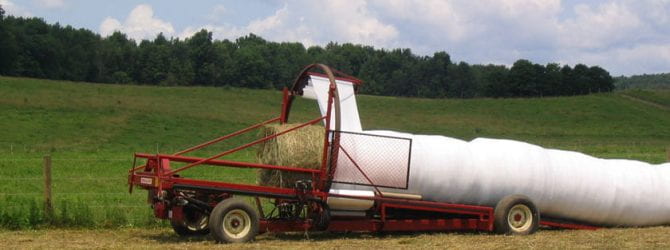RAPP, funded by New York State Department of Environmental Conservation, is charged in developing sustainable means for New York State farmers to manage their used agricultural plastics by recycling, reusing, and otherwise minimizing waste from plastics in agriculture. In New York State, RAPP works in collaboration with local partners to collect used plastic from farmers who follow RAPP guidelines to prepare their plastics for recycling.
What are Agricultural Plastics?
Plastics have taken the place of the longer lasting and/or natural materials that were used on farms. Many of these substitutions make good sense. Plastics are often safer to use, improve production efficiency, cost less, and permit more flexibility in management than the concrete silos, glass greenhouses, sisal twine and other products and packaging they replace.
Agricultural Plastics Include: 
- Dairy silage bags
- Bunker silo covers
- Bale wrap & Bale net
- Polytwine
- Maple tubing
- Irrigation drip tape & tubes
- Greenhouse & hoophouse covers
- High tunnels
- Nursery pots & plug trays
- Mulch & fumigation films
- Tarps
- Bird netting
- Pesticide & dairy chemical containers
- Seed & fertilizer bags
- Low tunnels
- Row covers
- Bee hive bodies & frames
- Aquaculture supplies
How Do Farmers Get Rid of Ag Plastics?
Some used Ag plastics are hauled to a solid waste transfer station or landfill. Much of the rest is either left in the fields, plowed into the ground, or burned in an open fire. Burning “Ag plastics” in an open fire generates high levels of dangerous polluting emissions (including particulates that settle in the lungs) and extremely toxic dioxins that can deposit on food and feed and enter the food chain. NYSDEC openly warns on their website that burning trash of any kind is illegal statewide. Stashing waste plastic on the farm can clog water channels, be a choking hazard for livestock and wildlife, and create breeding habitat for mosquitoes and rodents.
Goal = Recycling!
It isn’t an easy goal to achieve because Ag plastics are typically dirtier than other used plastics. They are also bulky and widely dispersed across the rural landscape, adding complexity and cost to collection.
To jump these hurdles, RAPP is:
- Promoting farmer adoption of Best Management Practices to keep Ag plastics in condition to be recycled.
- Cultivating manufacturing markets to process used plastic into new products (e.g., plastic lumber, roof tiles, and sweet crude oil).
- Promoting consumer purchase of products made from recycled Ag plastic.
- Facilitating a national dialog about product stewardship of agricultural plastics.
Best Management Practices: Keep Plastic Clean to Recycle
- Avoid- Mud and Manure as much as possible. Don’t run tractors over plastic. Locate silage bags and bales on a concrete pad, asphalt, or on high, dry ground.
- Cut- film before removing silage.
 Cut into pieces of size and weight one person can handle.
Cut into pieces of size and weight one person can handle. - Shake or Brush- off forage, soil and stones.
- Roll or Fold- dry film into bundles about the size of a large pillow (2’ x 3’). Stored film must be dry!
- Separate- different products and types. Do not mix different products in one bale (e.g., separate bale wrap from silage bags and bunker covers; twine or bale net from bale wrap, etc.). Separate cleaner film from dirtier. No PVC accepted.
- Chemical Containers- triple rinse to clean.
- Store Under Cover- keep clean and dry as possible- e.g., store on pallets in a barn, trailer, hay wagon or outside under a tarp.
Delaware County Recycling Rate
Did you know that Cornell Waste Management Institute reported in 2016 that the recycling rate for Ag Plastics in NYS is approximately 10%, but the recycling rate for Ag Plastics in Delaware County is 50%! Great job CCE, Farmers, & Delaware County Solid Waste!
For more information visit Cornell Waste Management Institute or contact Mariane Kiraly
Farm Business Management Educator
(607) 865-6531


